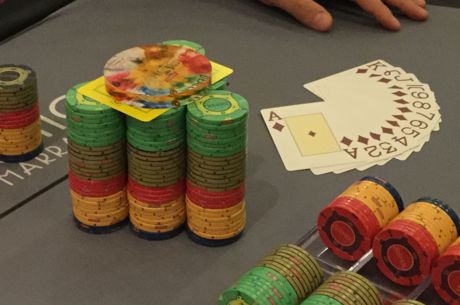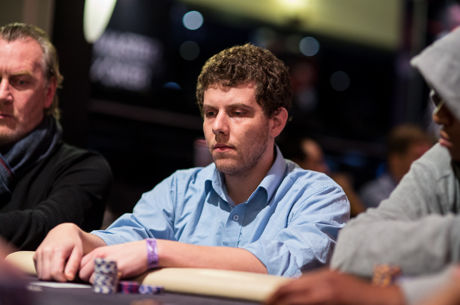Important Hold'em Lessons from a Seemingly Ordinary Hand

My friend and fellow poker blogger Tony popped up on Twitter last week inviting critique of a hand that he feared he had misplayed. The hand per se is mostly run-of-the-mill, but chatting with Tony about it raised some potentially useful points about how to approach poker decision-making.
The game was $1/$2 no-limit hold'em in a Reno casino. The Villain, Tony said, was an older gentleman who raised infrequently and bluffed even less. Tony had $205, Villain had about $400.
From second position (that is, UTG+1), Tony limped with A?K?. Two other players also limped. From the cutoff seat (right of the button), Villain raised to $18. Tony was the only caller. The flop was A?Q?5?. Tony checked, then folded when Villain bet $60.
Let's see how we can analyze this hand.
Some Preflop Math
We'll start with Tony's limp. Suited ace-king is, of course, one of the best starting hands in hold'em. Even given a positional disadvantage, it almost always deserves a raise, on the simple grounds that it is usually either the strongest hand or has approximately equal equity with a lower pocket pair (or another AxKx) being held elsewhere at the table.
Of course, once in a while you'll run your AxKx into KxKx, in which case you're about a 2-to-1 dog, or into AxAx, in which case you're about an 8-to-1 dog. Which, y'know, sucks.
How often will you be so unfortunate? We have 50 unseen cards left in the deck, which give 1,225 different two-card combinations that the other players could be dealt. (See my article here on how to do this kind of calculation.) There are just three aces left, which can form AxAx in three different ways. So the probability that any one opponent has AxAx is 3 out of 1,225, or about 0.25%.
We can't just multiply that 0.25% by the number of other players, because what each one has affects what the others can have. But it gives a decent ballpark approximation, and the math for an exact answer is dauntingly complicated. At a nine-handed table, there are eight opponents, so the probability is roughly 2% that one of them will have aces. The same calculation applies to kings, so we estimate the chance of running into one of the two feared hands at around 4%.
Put another way, about 96% of the time, ace-king will be either the best or roughly tied as the best starting hand. The straightforward play, then, is to raise.
It's perfectly reasonable to make this raise smaller than you might from late position, because, all else being equal, you want to play smaller pots from weak position than from strong position. I would usually raise to about $6 here.
The composition of some particular tables could make a good argument for the limp, but nothing Tony described makes me think that such conditions pertained here. The subsequent limps of two other players suggest a passive table �� exactly the kind on which a raise should be virtually automatic �� so that you're not out of position against five or six players.
The Villain's Raise
We get an important piece of information from the very fact of this tight Villain's preflop raise. I asked Tony to estimate what portion of hands he thought this particular opponent would raise with, given his position and three limpers. Tony estimated 5%. A strong, aggressive player should be raising a lot more than 5% in this spot, but that's probably a reasonable estimate, given his demographics and playing style.
So we fire up PokerStove and find that the top 5% of starting hands includes all pocket pairs down to 9x9x, plus AxKx-suited, AxKx-offsuit, AxQx-suited, AxJx-suited, and KxQx-suited.
Next we need to know how many combinations of each of these categories Villain could have. The fact that we have A?K? means that he can only have three combinations each of aces and kings, but he still has all six possible combinations of queens down to nines in his range. He can have three different suited ace-kings, and six different unsuited ace-kings. He can have three each of suited ace-queens and ace-jacks. Finally, he can have three suited king-queens. That all adds up to 48 different card combinations.
Of those, the ones we fear most �� aces and kings �� constitute just six of the 48 possibilities, meaning that we can estimate Villain to be dominating Tony only about 12% of the time.
Bet Sizing Tell
There's another important clue here, which isn't pure math, but observational. Villain raised to a whopping nine big blinds (to $18). It was also double the size of the pot formed by the blinds and limpers.
If you play $1/$2 games at Nevada casinos for a while, you'll come to recognize that this size of raise rarely signifies pocket aces or kings. It's a fairly transparent attempt to win the hand right now, settling for the $9 in the pot. Why? Because he has a hand that he has learned from sad experience is difficult to play after the flop.
The first such hand that should spring to mind with such an oversized raise is JxJx. After that, QxQx, 10x10x, and 9x9x are also plausible candidates for an $18 raise, given the range we're assigning to Villain. Finally, ace-king, suited or unsuited, is a possibility, with Villain reasoning that he'd rather win the pot now than risk missing the flop and having to play the rest of the hand with just ace-high.
But if you put a gun to my head and made me guess his exact holding at this point, I'd snap-answer "jacks."
On the Flop
Now the flop comes. Should we rejoice or tremble in fear? Well, we certainly like having top pair with the best kicker. (Or, as Jamie Gold famously referred to it, "top-top.") I was surprised to learn that Tony had check-folded here. He explained that he was worried that Villain now had him crushed, with aces, queens, or ace-queen. Is that a reasonable worry?
I think not. Villain holding AxAx is now far less likely than it was preflop, because there's another ace that we know he can't have in his hand. His only possible pair of aces at this point is exactly A?A?. The Q? on the board also reduces his QxQx possibilities from six to three. And since we had previously excluded ace-queen offsuit from his raising range, he now has just two possible ace-queen combos �� A?Q? or A?Q?.
In fact, if we stick with the preflop range on which we put him, it's now reduced from 48 to 38 different starting hands, given the additional constraints imposed by the ace and queen on the flop. Of those 38 possibilities, only six are the aces, queens, and ace-queen that have Tony in bad shape. The other approximately 84% of the time, his A?K? is strongly favored. Folding should therefore be out of the question.
Last Piece of Information
The last piece of information we get is Villain's flop bet. Tony said that he folded because he thought that Villain would bet only his AxAx, QxQx, and AxQx combinations. I think that's extremely unlikely to be a correct assessment, absent some strong, specific tell on this particular opponent.
Most players of this Villain's type will think approximately along these lines about Tony's holdings:
"He limp-called preflop from out of position. He probably has a small or medium pocket pair, or an ace with a weak or medium kicker �� not strong enough to raise, but enough of a hand to want to see if he can hit the flop. He then checked the flop. He could still have a small or medium pocket pair that missed, or an ace. It's unlikely that he flopped a set or two pair and is trapping me."
Given that reasoning, such a player would usually be expected to bet this flop when it's checked to him, with nearly his entire range, possibly excluding KxQx. With his AxKx and AxJx hands, he would be reasonably confident of having the best kicker, as he won't put Tony on the A?K? that he actually has. With his pocket pairs, he will think there's a good chance they're higher than Tony's pocket pairs, given Tony's preflop limp.
A check-call is not crazy. If Villain missed the flop, as seems most likely at this point (i.e., his remaining range is largely populated by what are now third pairs to this board), letting him make a continuation bet gets more money in the pot, whereas he would probably fold to a lead-out "donk" bet, in fear of the ace.
After one stab at such a continuation bet bluff, most players of this Villain's general description, in this game size, will conclude from a call that their opponent paired his ace, and give up. The result will be that Villain either checks the last two streets, or folds to any bet �� unless he were to get lucky and make a set, straight, or flush on the turn or river.
Bet Sizing, Again
But there's a fly in this ointment. The $60 continuation bet �� more than the pot �� is certainly surprising. It's not what we'd expect from this type of Villain, in this type of game, with any of his holdings. With his biggest hands �� sets and two pairs �� he'd probably bet smaller to extract more value, or even check back to trap. With his non-ace pocket pairs, he'd probably bet smaller as a probe, effectively using the bet to ask Tony, "Do you have an ace?" No need to risk $60 to get that answer.
Such a bet is a difficult piece of information from which to make confident inferences. But I think the most likely answer now is that Villain has AxKx, even though that was only a small part of the range we assigned him before the flop. If I'm right about that, the bet size is intended to discourage any Broadway draws from taking another card, and to prevent small pocket pairs from set-mining the turn. He would also expect it to get maximum value from the part of Tony's range that is an ace with a worse kicker.
Given all the action, I tentatively conclude that the most likely outcome of this hand would have been a split pot, with both players kissing their sisters, as the saying goes.
I'm usually reluctant to have my entire stack riding on top pair, even with top kicker, but in this specific situation, I think it would be good for either the whole pot or half of it the great majority of the time.
I think Tony playing passively (but not folding) in this out-of-position situation after the flop is fine, with check-calls all the way as needed, including up to all-in bet. Or taking the lead with a turn bet if Villain checks the flop. A check-raise all in on the flop is also defensible, because (1) we've concluded that Villain has Tony crushed only a small fraction of the time; (2) it might get a tight Villain to fold his own AxKx; and (3) if Tony is really lucky, he might even get a call from AxJx.
Conclusion
I think Tony saw "monsters under the bed" here. Both math and a consideration of how this kind of opponent typically plays reveal that the probability of facing a monster here was actually low enough to be worth risking one's stack.
This kind of detailed analysis is impossible to do while in the middle of a hand. However, doing it later, away from the table, helps clarify the likely reality of what was going on. Doing so frequently after your poker sessions opens up the mental pathways so that as you gain experience you can at least think in reasonably accurate general terms when put to a decision in the moment, and not flee from monsters that aren't there.
Robert Woolley lives in Asheville, NC. He spent several years in Las Vegas and chronicled his life in poker on the ��Poker Grump�� blog.
Want to stay atop all the latest in the poker world? If so, make sure to get PokerNews updates on your social media outlets. Follow us on Twitter and find us on both Facebook and Google+!









